Gas Turbine Engine: Types, Maintenance, Sustainable Technologies
VerifiedAdded on 2023/04/21
|10
|2949
|165
Report
AI Summary
This report provides a comprehensive overview of gas turbine engines, beginning with an introduction to the components and functions of a gas turbine engine, including the compressor, combustor, turbine, exhaust, and accessory sections. It delves into the different types of gas turbine engines, such as turbojet, turboprop, turbofan, and turboshaft engines, detailing their operations, advantages, and applications. The report also covers the maintenance aspects of gas turbine engines, emphasizing the importance of following manufacturer guidelines and inspecting compressor blades for damage. Furthermore, it discusses sustainable materials used in engine construction to improve fuel efficiency and reliability, along with new propulsion technologies like Maglev and marine propulsion systems. The report concludes by highlighting the environmentally friendly aspects of gas turbine engines, particularly their low pollutant emissions when using natural gas.
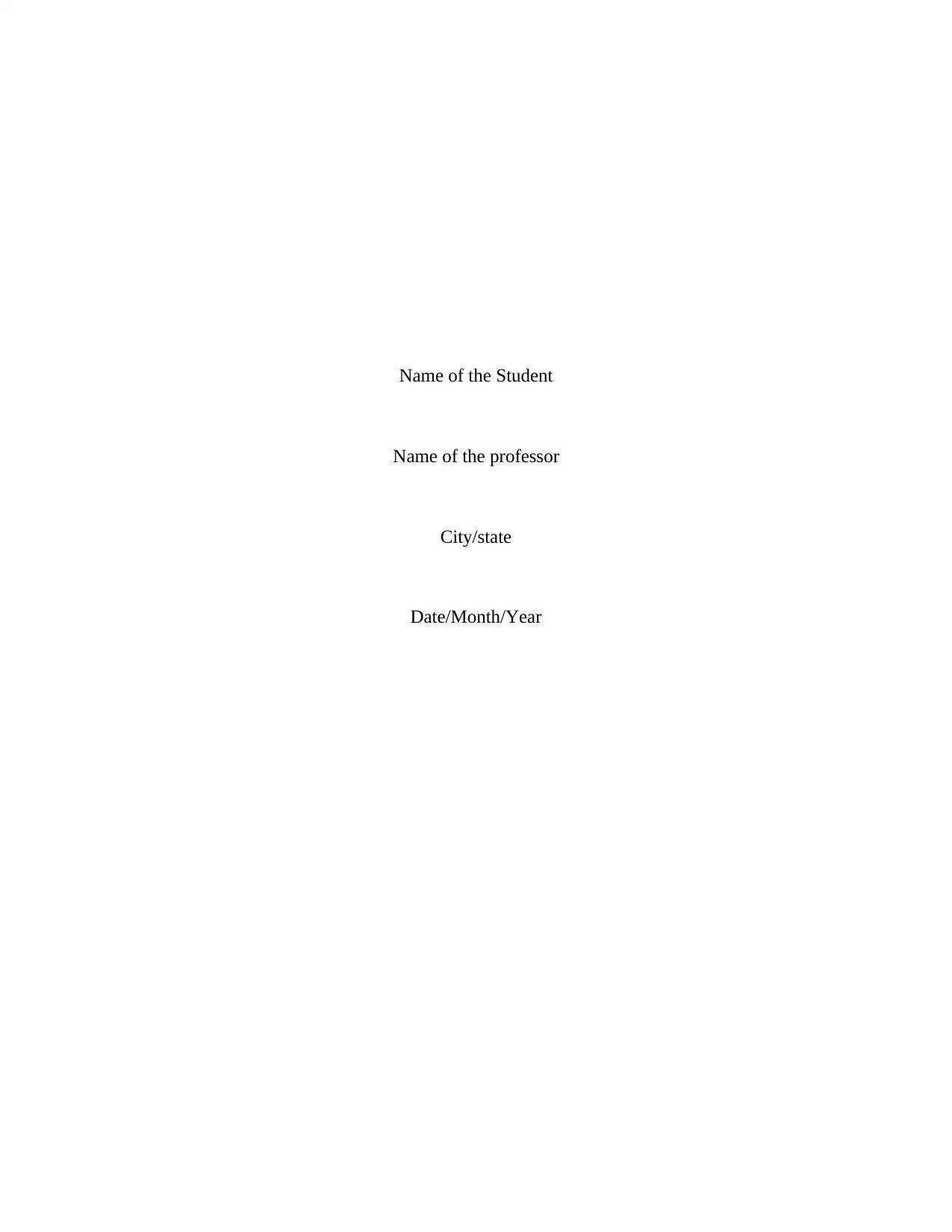
Name of the Student
Name of the professor
City/state
Date/Month/Year
Name of the professor
City/state
Date/Month/Year
Paraphrase This Document
Need a fresh take? Get an instant paraphrase of this document with our AI Paraphraser
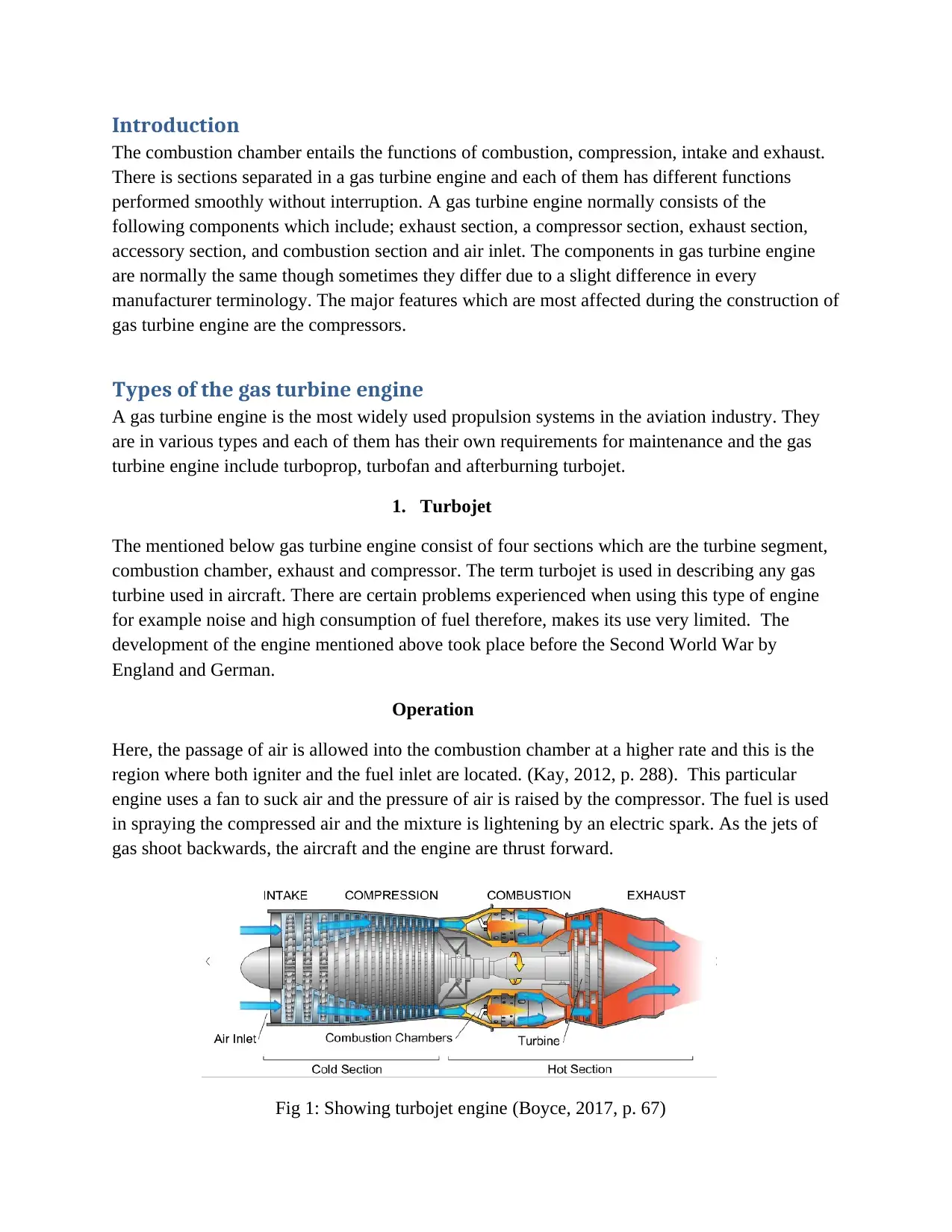
Introduction
The combustion chamber entails the functions of combustion, compression, intake and exhaust.
There is sections separated in a gas turbine engine and each of them has different functions
performed smoothly without interruption. A gas turbine engine normally consists of the
following components which include; exhaust section, a compressor section, exhaust section,
accessory section, and combustion section and air inlet. The components in gas turbine engine
are normally the same though sometimes they differ due to a slight difference in every
manufacturer terminology. The major features which are most affected during the construction of
gas turbine engine are the compressors.
Types of the gas turbine engine
A gas turbine engine is the most widely used propulsion systems in the aviation industry. They
are in various types and each of them has their own requirements for maintenance and the gas
turbine engine include turboprop, turbofan and afterburning turbojet.
1. Turbojet
The mentioned below gas turbine engine consist of four sections which are the turbine segment,
combustion chamber, exhaust and compressor. The term turbojet is used in describing any gas
turbine used in aircraft. There are certain problems experienced when using this type of engine
for example noise and high consumption of fuel therefore, makes its use very limited. The
development of the engine mentioned above took place before the Second World War by
England and German.
Operation
Here, the passage of air is allowed into the combustion chamber at a higher rate and this is the
region where both igniter and the fuel inlet are located. (Kay, 2012, p. 288). This particular
engine uses a fan to suck air and the pressure of air is raised by the compressor. The fuel is used
in spraying the compressed air and the mixture is lightening by an electric spark. As the jets of
gas shoot backwards, the aircraft and the engine are thrust forward.
Fig 1: Showing turbojet engine (Boyce, 2017, p. 67)
The combustion chamber entails the functions of combustion, compression, intake and exhaust.
There is sections separated in a gas turbine engine and each of them has different functions
performed smoothly without interruption. A gas turbine engine normally consists of the
following components which include; exhaust section, a compressor section, exhaust section,
accessory section, and combustion section and air inlet. The components in gas turbine engine
are normally the same though sometimes they differ due to a slight difference in every
manufacturer terminology. The major features which are most affected during the construction of
gas turbine engine are the compressors.
Types of the gas turbine engine
A gas turbine engine is the most widely used propulsion systems in the aviation industry. They
are in various types and each of them has their own requirements for maintenance and the gas
turbine engine include turboprop, turbofan and afterburning turbojet.
1. Turbojet
The mentioned below gas turbine engine consist of four sections which are the turbine segment,
combustion chamber, exhaust and compressor. The term turbojet is used in describing any gas
turbine used in aircraft. There are certain problems experienced when using this type of engine
for example noise and high consumption of fuel therefore, makes its use very limited. The
development of the engine mentioned above took place before the Second World War by
England and German.
Operation
Here, the passage of air is allowed into the combustion chamber at a higher rate and this is the
region where both igniter and the fuel inlet are located. (Kay, 2012, p. 288). This particular
engine uses a fan to suck air and the pressure of air is raised by the compressor. The fuel is used
in spraying the compressed air and the mixture is lightening by an electric spark. As the jets of
gas shoot backwards, the aircraft and the engine are thrust forward.
Fig 1: Showing turbojet engine (Boyce, 2017, p. 67)
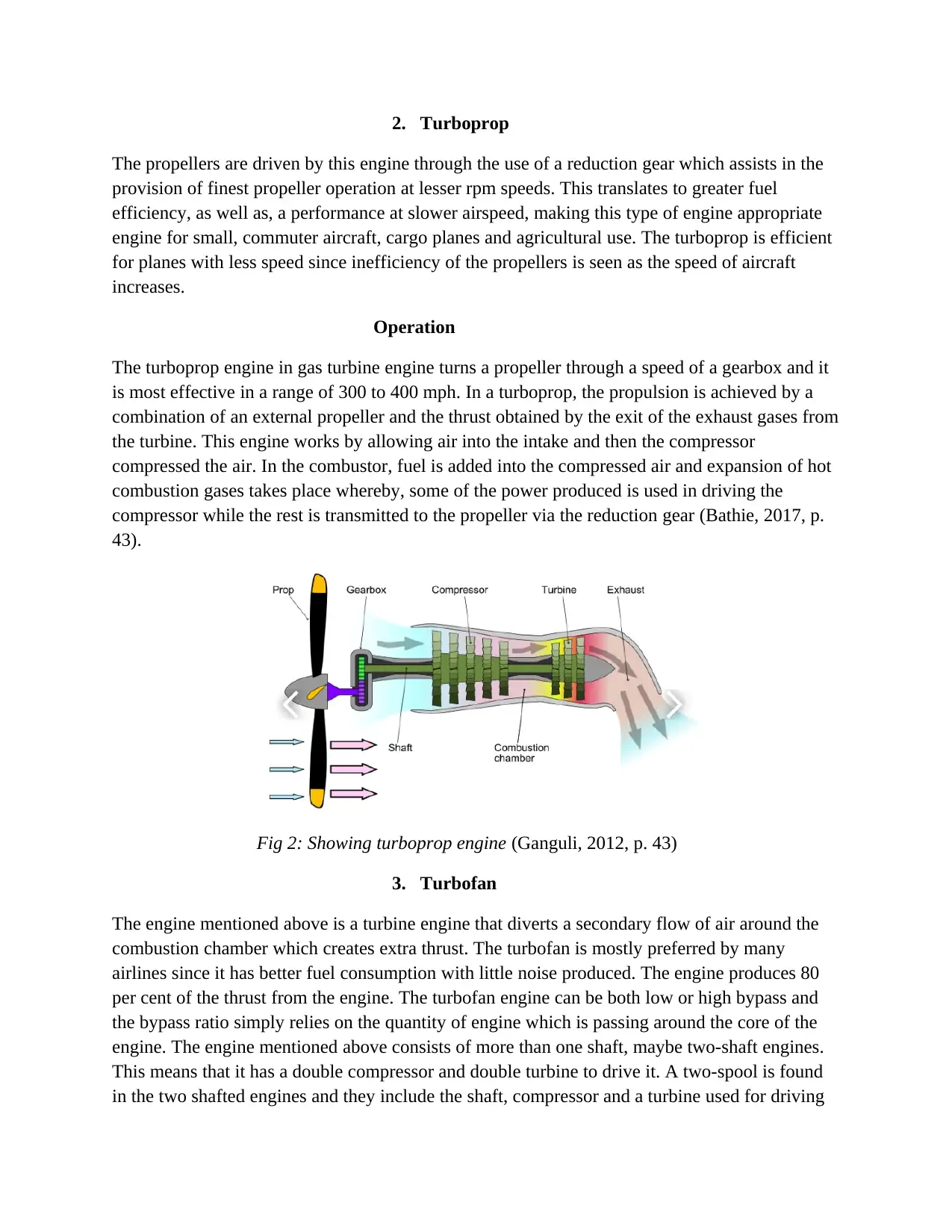
2. Turboprop
The propellers are driven by this engine through the use of a reduction gear which assists in the
provision of finest propeller operation at lesser rpm speeds. This translates to greater fuel
efficiency, as well as, a performance at slower airspeed, making this type of engine appropriate
engine for small, commuter aircraft, cargo planes and agricultural use. The turboprop is efficient
for planes with less speed since inefficiency of the propellers is seen as the speed of aircraft
increases.
Operation
The turboprop engine in gas turbine engine turns a propeller through a speed of a gearbox and it
is most effective in a range of 300 to 400 mph. In a turboprop, the propulsion is achieved by a
combination of an external propeller and the thrust obtained by the exit of the exhaust gases from
the turbine. This engine works by allowing air into the intake and then the compressor
compressed the air. In the combustor, fuel is added into the compressed air and expansion of hot
combustion gases takes place whereby, some of the power produced is used in driving the
compressor while the rest is transmitted to the propeller via the reduction gear (Bathie, 2017, p.
43).
Fig 2: Showing turboprop engine (Ganguli, 2012, p. 43)
3. Turbofan
The engine mentioned above is a turbine engine that diverts a secondary flow of air around the
combustion chamber which creates extra thrust. The turbofan is mostly preferred by many
airlines since it has better fuel consumption with little noise produced. The engine produces 80
per cent of the thrust from the engine. The turbofan engine can be both low or high bypass and
the bypass ratio simply relies on the quantity of engine which is passing around the core of the
engine. The engine mentioned above consists of more than one shaft, maybe two-shaft engines.
This means that it has a double compressor and double turbine to drive it. A two-spool is found
in the two shafted engines and they include the shaft, compressor and a turbine used for driving
The propellers are driven by this engine through the use of a reduction gear which assists in the
provision of finest propeller operation at lesser rpm speeds. This translates to greater fuel
efficiency, as well as, a performance at slower airspeed, making this type of engine appropriate
engine for small, commuter aircraft, cargo planes and agricultural use. The turboprop is efficient
for planes with less speed since inefficiency of the propellers is seen as the speed of aircraft
increases.
Operation
The turboprop engine in gas turbine engine turns a propeller through a speed of a gearbox and it
is most effective in a range of 300 to 400 mph. In a turboprop, the propulsion is achieved by a
combination of an external propeller and the thrust obtained by the exit of the exhaust gases from
the turbine. This engine works by allowing air into the intake and then the compressor
compressed the air. In the combustor, fuel is added into the compressed air and expansion of hot
combustion gases takes place whereby, some of the power produced is used in driving the
compressor while the rest is transmitted to the propeller via the reduction gear (Bathie, 2017, p.
43).
Fig 2: Showing turboprop engine (Ganguli, 2012, p. 43)
3. Turbofan
The engine mentioned above is a turbine engine that diverts a secondary flow of air around the
combustion chamber which creates extra thrust. The turbofan is mostly preferred by many
airlines since it has better fuel consumption with little noise produced. The engine produces 80
per cent of the thrust from the engine. The turbofan engine can be both low or high bypass and
the bypass ratio simply relies on the quantity of engine which is passing around the core of the
engine. The engine mentioned above consists of more than one shaft, maybe two-shaft engines.
This means that it has a double compressor and double turbine to drive it. A two-spool is found
in the two shafted engines and they include the shaft, compressor and a turbine used for driving
⊘ This is a preview!⊘
Do you want full access?
Subscribe today to unlock all pages.

Trusted by 1+ million students worldwide
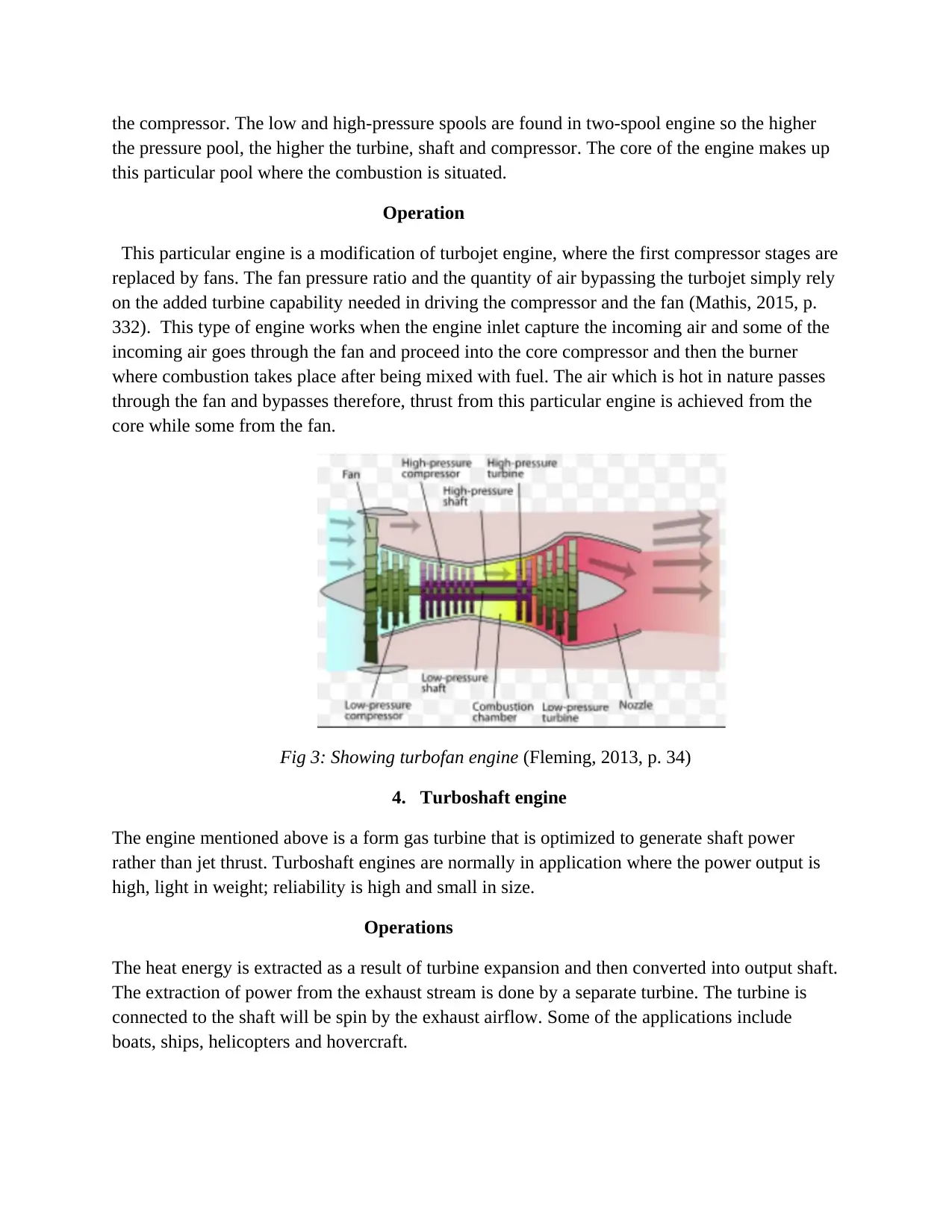
the compressor. The low and high-pressure spools are found in two-spool engine so the higher
the pressure pool, the higher the turbine, shaft and compressor. The core of the engine makes up
this particular pool where the combustion is situated.
Operation
This particular engine is a modification of turbojet engine, where the first compressor stages are
replaced by fans. The fan pressure ratio and the quantity of air bypassing the turbojet simply rely
on the added turbine capability needed in driving the compressor and the fan (Mathis, 2015, p.
332). This type of engine works when the engine inlet capture the incoming air and some of the
incoming air goes through the fan and proceed into the core compressor and then the burner
where combustion takes place after being mixed with fuel. The air which is hot in nature passes
through the fan and bypasses therefore, thrust from this particular engine is achieved from the
core while some from the fan.
Fig 3: Showing turbofan engine (Fleming, 2013, p. 34)
4. Turboshaft engine
The engine mentioned above is a form gas turbine that is optimized to generate shaft power
rather than jet thrust. Turboshaft engines are normally in application where the power output is
high, light in weight; reliability is high and small in size.
Operations
The heat energy is extracted as a result of turbine expansion and then converted into output shaft.
The extraction of power from the exhaust stream is done by a separate turbine. The turbine is
connected to the shaft will be spin by the exhaust airflow. Some of the applications include
boats, ships, helicopters and hovercraft.
the pressure pool, the higher the turbine, shaft and compressor. The core of the engine makes up
this particular pool where the combustion is situated.
Operation
This particular engine is a modification of turbojet engine, where the first compressor stages are
replaced by fans. The fan pressure ratio and the quantity of air bypassing the turbojet simply rely
on the added turbine capability needed in driving the compressor and the fan (Mathis, 2015, p.
332). This type of engine works when the engine inlet capture the incoming air and some of the
incoming air goes through the fan and proceed into the core compressor and then the burner
where combustion takes place after being mixed with fuel. The air which is hot in nature passes
through the fan and bypasses therefore, thrust from this particular engine is achieved from the
core while some from the fan.
Fig 3: Showing turbofan engine (Fleming, 2013, p. 34)
4. Turboshaft engine
The engine mentioned above is a form gas turbine that is optimized to generate shaft power
rather than jet thrust. Turboshaft engines are normally in application where the power output is
high, light in weight; reliability is high and small in size.
Operations
The heat energy is extracted as a result of turbine expansion and then converted into output shaft.
The extraction of power from the exhaust stream is done by a separate turbine. The turbine is
connected to the shaft will be spin by the exhaust airflow. Some of the applications include
boats, ships, helicopters and hovercraft.
Paraphrase This Document
Need a fresh take? Get an instant paraphrase of this document with our AI Paraphraser
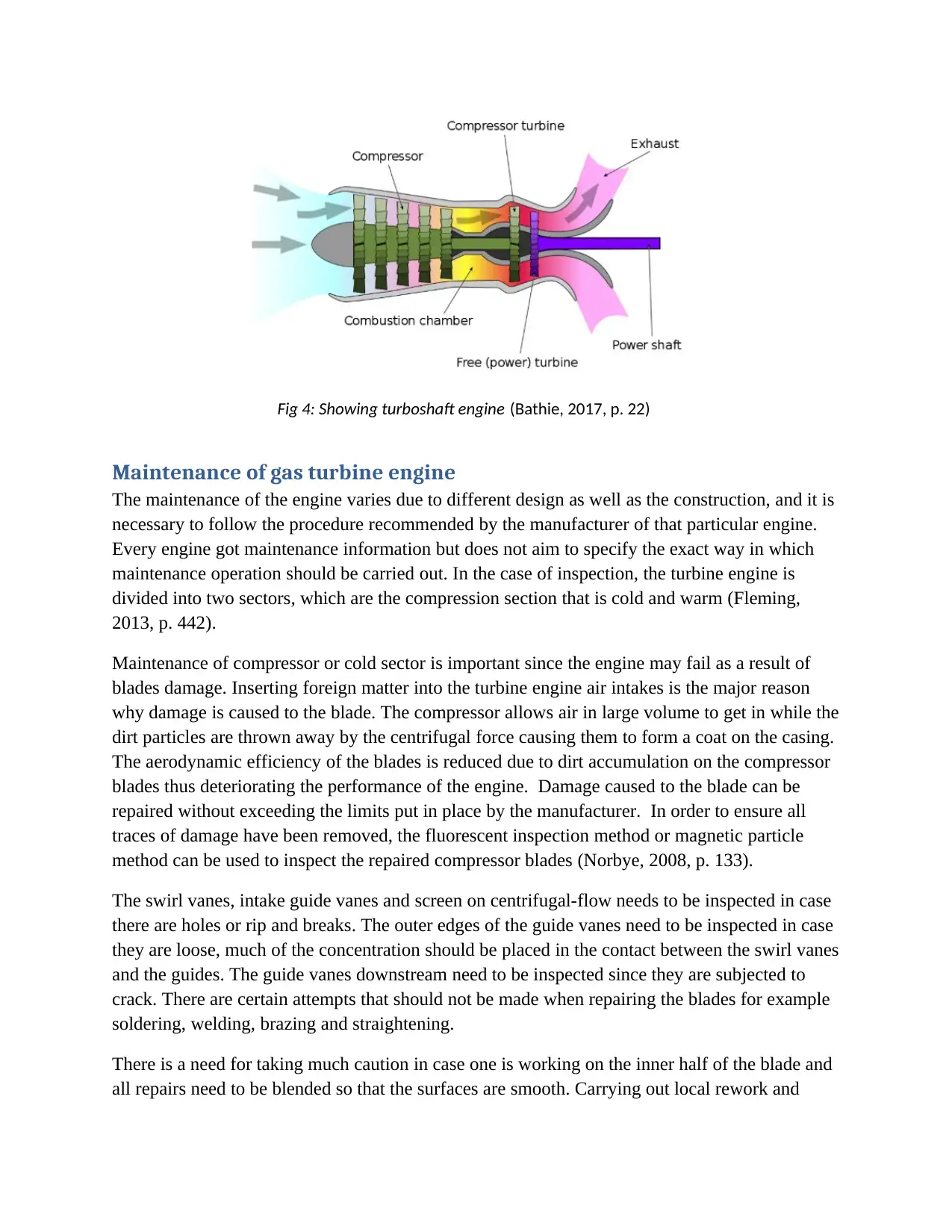
Fig 4: Showing turboshaft engine (Bathie, 2017, p. 22)
Maintenance of gas turbine engine
The maintenance of the engine varies due to different design as well as the construction, and it is
necessary to follow the procedure recommended by the manufacturer of that particular engine.
Every engine got maintenance information but does not aim to specify the exact way in which
maintenance operation should be carried out. In the case of inspection, the turbine engine is
divided into two sectors, which are the compression section that is cold and warm (Fleming,
2013, p. 442).
Maintenance of compressor or cold sector is important since the engine may fail as a result of
blades damage. Inserting foreign matter into the turbine engine air intakes is the major reason
why damage is caused to the blade. The compressor allows air in large volume to get in while the
dirt particles are thrown away by the centrifugal force causing them to form a coat on the casing.
The aerodynamic efficiency of the blades is reduced due to dirt accumulation on the compressor
blades thus deteriorating the performance of the engine. Damage caused to the blade can be
repaired without exceeding the limits put in place by the manufacturer. In order to ensure all
traces of damage have been removed, the fluorescent inspection method or magnetic particle
method can be used to inspect the repaired compressor blades (Norbye, 2008, p. 133).
The swirl vanes, intake guide vanes and screen on centrifugal-flow needs to be inspected in case
there are holes or rip and breaks. The outer edges of the guide vanes need to be inspected in case
they are loose, much of the concentration should be placed in the contact between the swirl vanes
and the guides. The guide vanes downstream need to be inspected since they are subjected to
crack. There are certain attempts that should not be made when repairing the blades for example
soldering, welding, brazing and straightening.
There is a need for taking much caution in case one is working on the inner half of the blade and
all repairs need to be blended so that the surfaces are smooth. Carrying out local rework and
Maintenance of gas turbine engine
The maintenance of the engine varies due to different design as well as the construction, and it is
necessary to follow the procedure recommended by the manufacturer of that particular engine.
Every engine got maintenance information but does not aim to specify the exact way in which
maintenance operation should be carried out. In the case of inspection, the turbine engine is
divided into two sectors, which are the compression section that is cold and warm (Fleming,
2013, p. 442).
Maintenance of compressor or cold sector is important since the engine may fail as a result of
blades damage. Inserting foreign matter into the turbine engine air intakes is the major reason
why damage is caused to the blade. The compressor allows air in large volume to get in while the
dirt particles are thrown away by the centrifugal force causing them to form a coat on the casing.
The aerodynamic efficiency of the blades is reduced due to dirt accumulation on the compressor
blades thus deteriorating the performance of the engine. Damage caused to the blade can be
repaired without exceeding the limits put in place by the manufacturer. In order to ensure all
traces of damage have been removed, the fluorescent inspection method or magnetic particle
method can be used to inspect the repaired compressor blades (Norbye, 2008, p. 133).
The swirl vanes, intake guide vanes and screen on centrifugal-flow needs to be inspected in case
there are holes or rip and breaks. The outer edges of the guide vanes need to be inspected in case
they are loose, much of the concentration should be placed in the contact between the swirl vanes
and the guides. The guide vanes downstream need to be inspected since they are subjected to
crack. There are certain attempts that should not be made when repairing the blades for example
soldering, welding, brazing and straightening.
There is a need for taking much caution in case one is working on the inner half of the blade and
all repairs need to be blended so that the surfaces are smooth. Carrying out local rework and
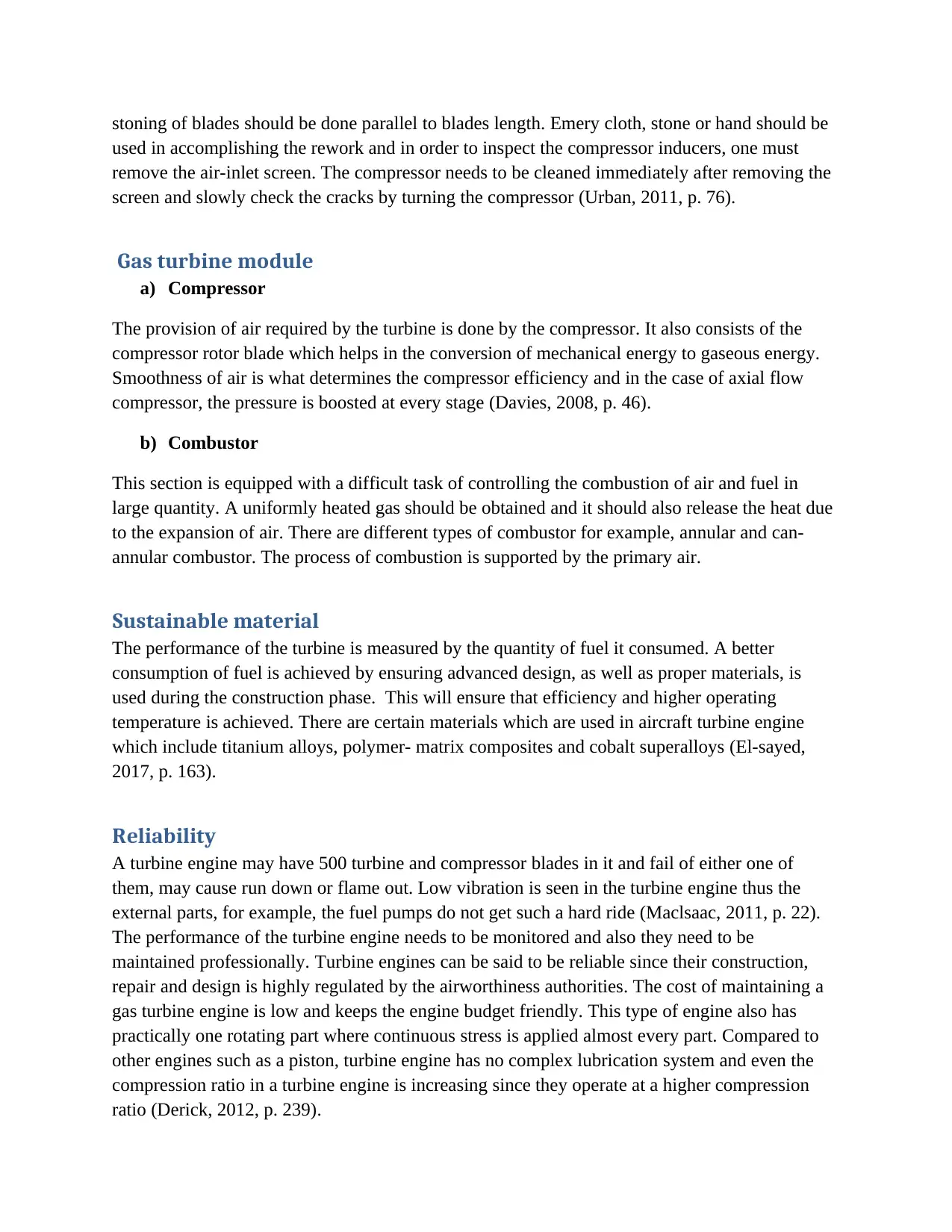
stoning of blades should be done parallel to blades length. Emery cloth, stone or hand should be
used in accomplishing the rework and in order to inspect the compressor inducers, one must
remove the air-inlet screen. The compressor needs to be cleaned immediately after removing the
screen and slowly check the cracks by turning the compressor (Urban, 2011, p. 76).
Gas turbine module
a) Compressor
The provision of air required by the turbine is done by the compressor. It also consists of the
compressor rotor blade which helps in the conversion of mechanical energy to gaseous energy.
Smoothness of air is what determines the compressor efficiency and in the case of axial flow
compressor, the pressure is boosted at every stage (Davies, 2008, p. 46).
b) Combustor
This section is equipped with a difficult task of controlling the combustion of air and fuel in
large quantity. A uniformly heated gas should be obtained and it should also release the heat due
to the expansion of air. There are different types of combustor for example, annular and can-
annular combustor. The process of combustion is supported by the primary air.
Sustainable material
The performance of the turbine is measured by the quantity of fuel it consumed. A better
consumption of fuel is achieved by ensuring advanced design, as well as proper materials, is
used during the construction phase. This will ensure that efficiency and higher operating
temperature is achieved. There are certain materials which are used in aircraft turbine engine
which include titanium alloys, polymer- matrix composites and cobalt superalloys (El-sayed,
2017, p. 163).
Reliability
A turbine engine may have 500 turbine and compressor blades in it and fail of either one of
them, may cause run down or flame out. Low vibration is seen in the turbine engine thus the
external parts, for example, the fuel pumps do not get such a hard ride (Maclsaac, 2011, p. 22).
The performance of the turbine engine needs to be monitored and also they need to be
maintained professionally. Turbine engines can be said to be reliable since their construction,
repair and design is highly regulated by the airworthiness authorities. The cost of maintaining a
gas turbine engine is low and keeps the engine budget friendly. This type of engine also has
practically one rotating part where continuous stress is applied almost every part. Compared to
other engines such as a piston, turbine engine has no complex lubrication system and even the
compression ratio in a turbine engine is increasing since they operate at a higher compression
ratio (Derick, 2012, p. 239).
used in accomplishing the rework and in order to inspect the compressor inducers, one must
remove the air-inlet screen. The compressor needs to be cleaned immediately after removing the
screen and slowly check the cracks by turning the compressor (Urban, 2011, p. 76).
Gas turbine module
a) Compressor
The provision of air required by the turbine is done by the compressor. It also consists of the
compressor rotor blade which helps in the conversion of mechanical energy to gaseous energy.
Smoothness of air is what determines the compressor efficiency and in the case of axial flow
compressor, the pressure is boosted at every stage (Davies, 2008, p. 46).
b) Combustor
This section is equipped with a difficult task of controlling the combustion of air and fuel in
large quantity. A uniformly heated gas should be obtained and it should also release the heat due
to the expansion of air. There are different types of combustor for example, annular and can-
annular combustor. The process of combustion is supported by the primary air.
Sustainable material
The performance of the turbine is measured by the quantity of fuel it consumed. A better
consumption of fuel is achieved by ensuring advanced design, as well as proper materials, is
used during the construction phase. This will ensure that efficiency and higher operating
temperature is achieved. There are certain materials which are used in aircraft turbine engine
which include titanium alloys, polymer- matrix composites and cobalt superalloys (El-sayed,
2017, p. 163).
Reliability
A turbine engine may have 500 turbine and compressor blades in it and fail of either one of
them, may cause run down or flame out. Low vibration is seen in the turbine engine thus the
external parts, for example, the fuel pumps do not get such a hard ride (Maclsaac, 2011, p. 22).
The performance of the turbine engine needs to be monitored and also they need to be
maintained professionally. Turbine engines can be said to be reliable since their construction,
repair and design is highly regulated by the airworthiness authorities. The cost of maintaining a
gas turbine engine is low and keeps the engine budget friendly. This type of engine also has
practically one rotating part where continuous stress is applied almost every part. Compared to
other engines such as a piston, turbine engine has no complex lubrication system and even the
compression ratio in a turbine engine is increasing since they operate at a higher compression
ratio (Derick, 2012, p. 239).
⊘ This is a preview!⊘
Do you want full access?
Subscribe today to unlock all pages.

Trusted by 1+ million students worldwide
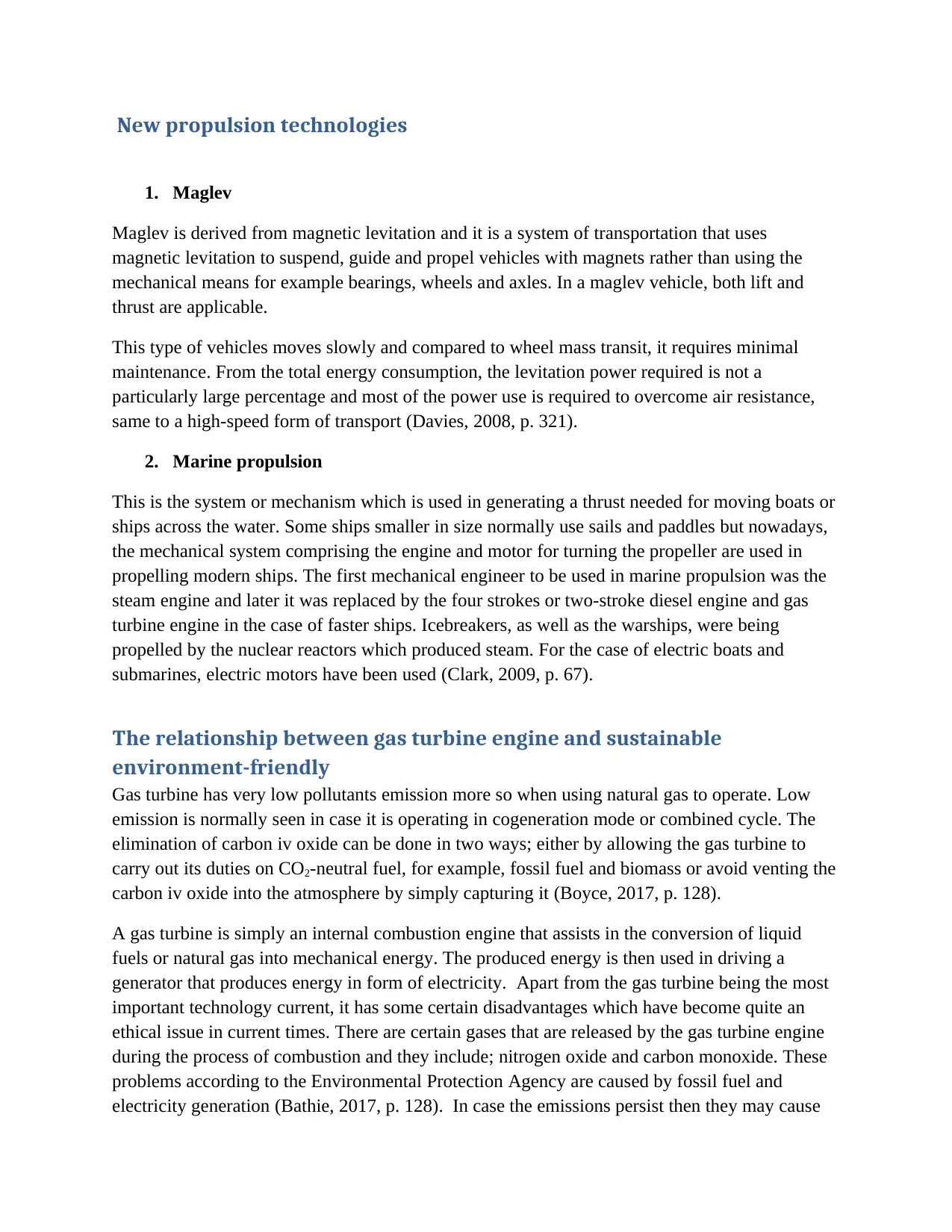
New propulsion technologies
1. Maglev
Maglev is derived from magnetic levitation and it is a system of transportation that uses
magnetic levitation to suspend, guide and propel vehicles with magnets rather than using the
mechanical means for example bearings, wheels and axles. In a maglev vehicle, both lift and
thrust are applicable.
This type of vehicles moves slowly and compared to wheel mass transit, it requires minimal
maintenance. From the total energy consumption, the levitation power required is not a
particularly large percentage and most of the power use is required to overcome air resistance,
same to a high-speed form of transport (Davies, 2008, p. 321).
2. Marine propulsion
This is the system or mechanism which is used in generating a thrust needed for moving boats or
ships across the water. Some ships smaller in size normally use sails and paddles but nowadays,
the mechanical system comprising the engine and motor for turning the propeller are used in
propelling modern ships. The first mechanical engineer to be used in marine propulsion was the
steam engine and later it was replaced by the four strokes or two-stroke diesel engine and gas
turbine engine in the case of faster ships. Icebreakers, as well as the warships, were being
propelled by the nuclear reactors which produced steam. For the case of electric boats and
submarines, electric motors have been used (Clark, 2009, p. 67).
The relationship between gas turbine engine and sustainable
environment-friendly
Gas turbine has very low pollutants emission more so when using natural gas to operate. Low
emission is normally seen in case it is operating in cogeneration mode or combined cycle. The
elimination of carbon iv oxide can be done in two ways; either by allowing the gas turbine to
carry out its duties on CO2-neutral fuel, for example, fossil fuel and biomass or avoid venting the
carbon iv oxide into the atmosphere by simply capturing it (Boyce, 2017, p. 128).
A gas turbine is simply an internal combustion engine that assists in the conversion of liquid
fuels or natural gas into mechanical energy. The produced energy is then used in driving a
generator that produces energy in form of electricity. Apart from the gas turbine being the most
important technology current, it has some certain disadvantages which have become quite an
ethical issue in current times. There are certain gases that are released by the gas turbine engine
during the process of combustion and they include; nitrogen oxide and carbon monoxide. These
problems according to the Environmental Protection Agency are caused by fossil fuel and
electricity generation (Bathie, 2017, p. 128). In case the emissions persist then they may cause
1. Maglev
Maglev is derived from magnetic levitation and it is a system of transportation that uses
magnetic levitation to suspend, guide and propel vehicles with magnets rather than using the
mechanical means for example bearings, wheels and axles. In a maglev vehicle, both lift and
thrust are applicable.
This type of vehicles moves slowly and compared to wheel mass transit, it requires minimal
maintenance. From the total energy consumption, the levitation power required is not a
particularly large percentage and most of the power use is required to overcome air resistance,
same to a high-speed form of transport (Davies, 2008, p. 321).
2. Marine propulsion
This is the system or mechanism which is used in generating a thrust needed for moving boats or
ships across the water. Some ships smaller in size normally use sails and paddles but nowadays,
the mechanical system comprising the engine and motor for turning the propeller are used in
propelling modern ships. The first mechanical engineer to be used in marine propulsion was the
steam engine and later it was replaced by the four strokes or two-stroke diesel engine and gas
turbine engine in the case of faster ships. Icebreakers, as well as the warships, were being
propelled by the nuclear reactors which produced steam. For the case of electric boats and
submarines, electric motors have been used (Clark, 2009, p. 67).
The relationship between gas turbine engine and sustainable
environment-friendly
Gas turbine has very low pollutants emission more so when using natural gas to operate. Low
emission is normally seen in case it is operating in cogeneration mode or combined cycle. The
elimination of carbon iv oxide can be done in two ways; either by allowing the gas turbine to
carry out its duties on CO2-neutral fuel, for example, fossil fuel and biomass or avoid venting the
carbon iv oxide into the atmosphere by simply capturing it (Boyce, 2017, p. 128).
A gas turbine is simply an internal combustion engine that assists in the conversion of liquid
fuels or natural gas into mechanical energy. The produced energy is then used in driving a
generator that produces energy in form of electricity. Apart from the gas turbine being the most
important technology current, it has some certain disadvantages which have become quite an
ethical issue in current times. There are certain gases that are released by the gas turbine engine
during the process of combustion and they include; nitrogen oxide and carbon monoxide. These
problems according to the Environmental Protection Agency are caused by fossil fuel and
electricity generation (Bathie, 2017, p. 128). In case the emissions persist then they may cause
Paraphrase This Document
Need a fresh take? Get an instant paraphrase of this document with our AI Paraphraser
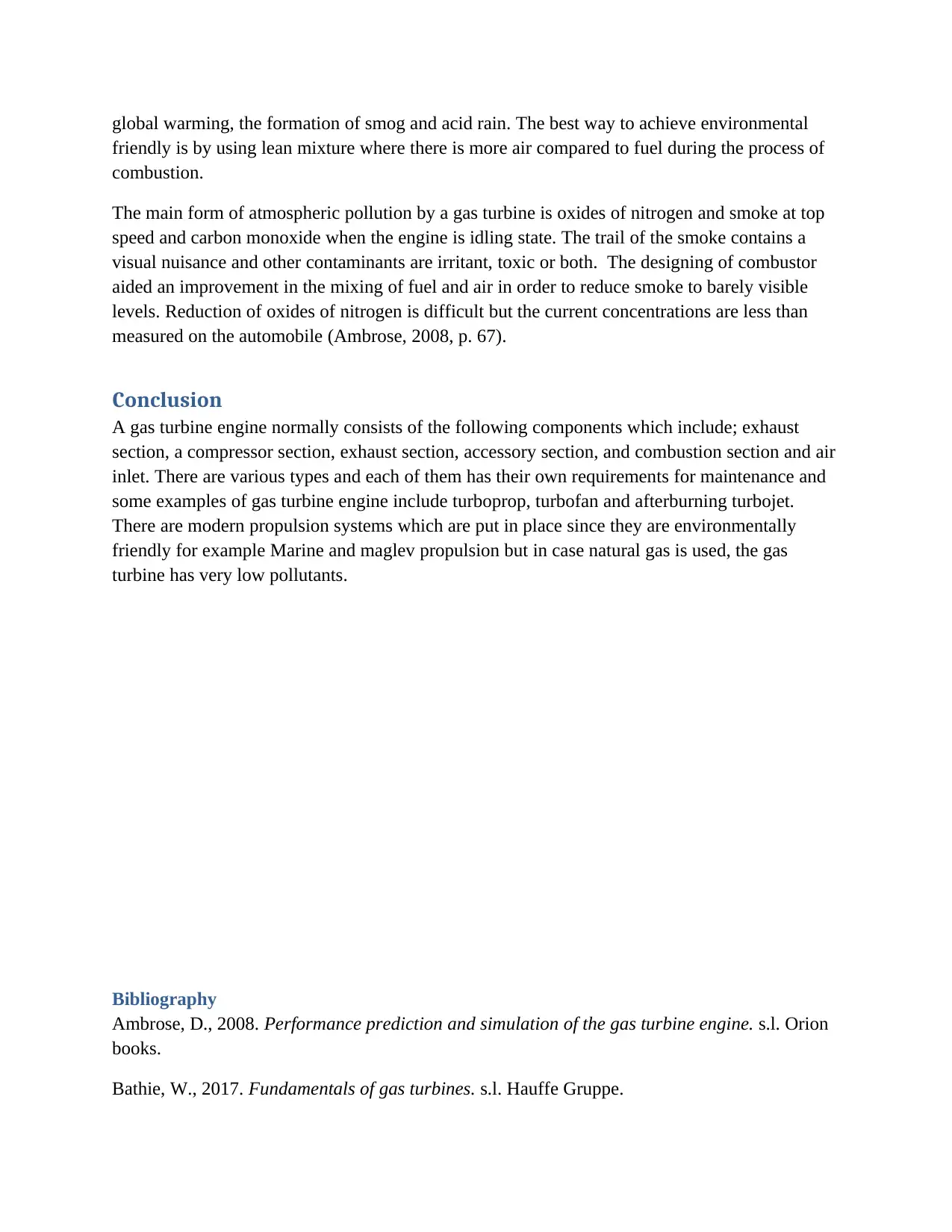
global warming, the formation of smog and acid rain. The best way to achieve environmental
friendly is by using lean mixture where there is more air compared to fuel during the process of
combustion.
The main form of atmospheric pollution by a gas turbine is oxides of nitrogen and smoke at top
speed and carbon monoxide when the engine is idling state. The trail of the smoke contains a
visual nuisance and other contaminants are irritant, toxic or both. The designing of combustor
aided an improvement in the mixing of fuel and air in order to reduce smoke to barely visible
levels. Reduction of oxides of nitrogen is difficult but the current concentrations are less than
measured on the automobile (Ambrose, 2008, p. 67).
Conclusion
A gas turbine engine normally consists of the following components which include; exhaust
section, a compressor section, exhaust section, accessory section, and combustion section and air
inlet. There are various types and each of them has their own requirements for maintenance and
some examples of gas turbine engine include turboprop, turbofan and afterburning turbojet.
There are modern propulsion systems which are put in place since they are environmentally
friendly for example Marine and maglev propulsion but in case natural gas is used, the gas
turbine has very low pollutants.
Bibliography
Ambrose, D., 2008. Performance prediction and simulation of the gas turbine engine. s.l. Orion
books.
Bathie, W., 2017. Fundamentals of gas turbines. s.l. Hauffe Gruppe.
friendly is by using lean mixture where there is more air compared to fuel during the process of
combustion.
The main form of atmospheric pollution by a gas turbine is oxides of nitrogen and smoke at top
speed and carbon monoxide when the engine is idling state. The trail of the smoke contains a
visual nuisance and other contaminants are irritant, toxic or both. The designing of combustor
aided an improvement in the mixing of fuel and air in order to reduce smoke to barely visible
levels. Reduction of oxides of nitrogen is difficult but the current concentrations are less than
measured on the automobile (Ambrose, 2008, p. 67).
Conclusion
A gas turbine engine normally consists of the following components which include; exhaust
section, a compressor section, exhaust section, accessory section, and combustion section and air
inlet. There are various types and each of them has their own requirements for maintenance and
some examples of gas turbine engine include turboprop, turbofan and afterburning turbojet.
There are modern propulsion systems which are put in place since they are environmentally
friendly for example Marine and maglev propulsion but in case natural gas is used, the gas
turbine has very low pollutants.
Bibliography
Ambrose, D., 2008. Performance prediction and simulation of the gas turbine engine. s.l. Orion
books.
Bathie, W., 2017. Fundamentals of gas turbines. s.l. Hauffe Gruppe.
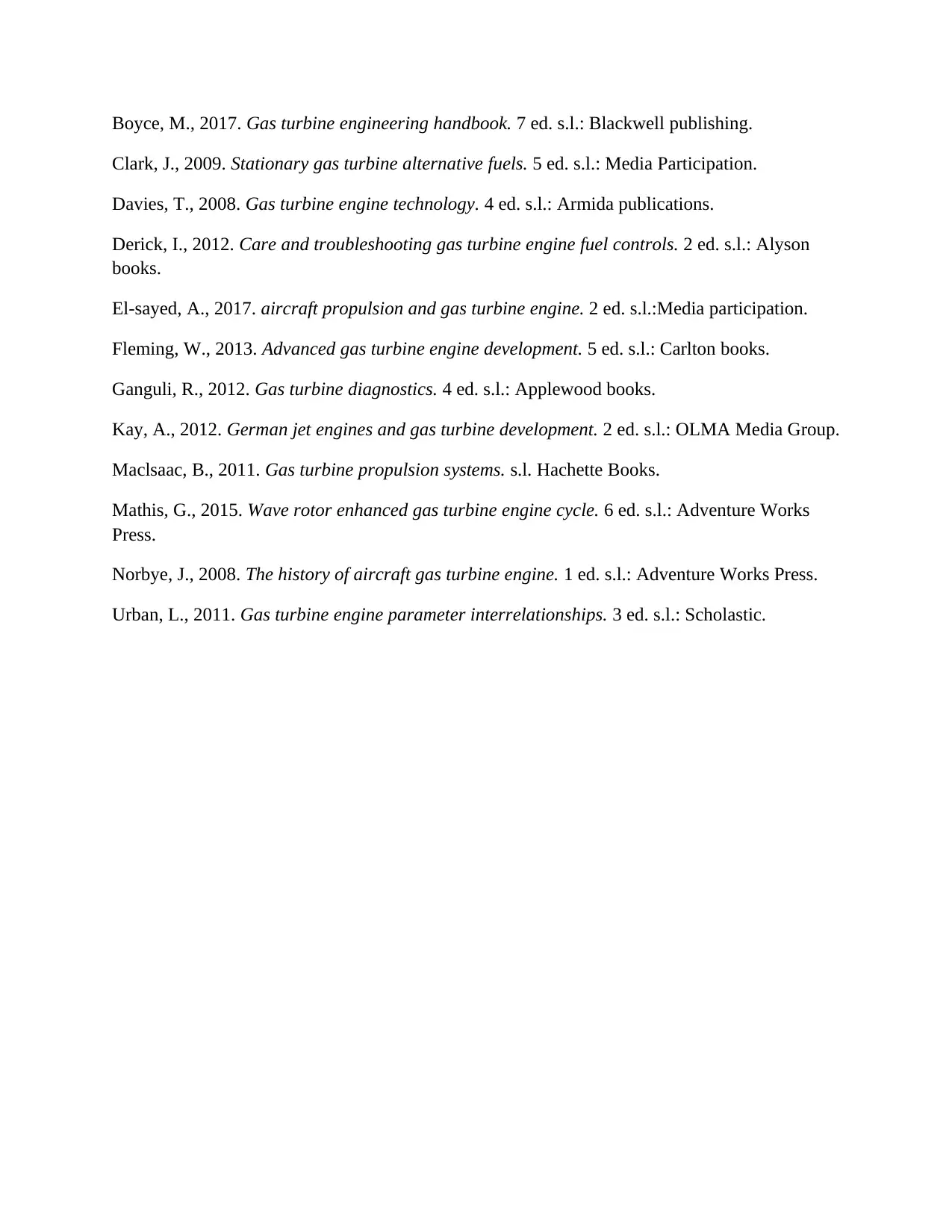
Boyce, M., 2017. Gas turbine engineering handbook. 7 ed. s.l.: Blackwell publishing.
Clark, J., 2009. Stationary gas turbine alternative fuels. 5 ed. s.l.: Media Participation.
Davies, T., 2008. Gas turbine engine technology. 4 ed. s.l.: Armida publications.
Derick, I., 2012. Care and troubleshooting gas turbine engine fuel controls. 2 ed. s.l.: Alyson
books.
El-sayed, A., 2017. aircraft propulsion and gas turbine engine. 2 ed. s.l.:Media participation.
Fleming, W., 2013. Advanced gas turbine engine development. 5 ed. s.l.: Carlton books.
Ganguli, R., 2012. Gas turbine diagnostics. 4 ed. s.l.: Applewood books.
Kay, A., 2012. German jet engines and gas turbine development. 2 ed. s.l.: OLMA Media Group.
Maclsaac, B., 2011. Gas turbine propulsion systems. s.l. Hachette Books.
Mathis, G., 2015. Wave rotor enhanced gas turbine engine cycle. 6 ed. s.l.: Adventure Works
Press.
Norbye, J., 2008. The history of aircraft gas turbine engine. 1 ed. s.l.: Adventure Works Press.
Urban, L., 2011. Gas turbine engine parameter interrelationships. 3 ed. s.l.: Scholastic.
Clark, J., 2009. Stationary gas turbine alternative fuels. 5 ed. s.l.: Media Participation.
Davies, T., 2008. Gas turbine engine technology. 4 ed. s.l.: Armida publications.
Derick, I., 2012. Care and troubleshooting gas turbine engine fuel controls. 2 ed. s.l.: Alyson
books.
El-sayed, A., 2017. aircraft propulsion and gas turbine engine. 2 ed. s.l.:Media participation.
Fleming, W., 2013. Advanced gas turbine engine development. 5 ed. s.l.: Carlton books.
Ganguli, R., 2012. Gas turbine diagnostics. 4 ed. s.l.: Applewood books.
Kay, A., 2012. German jet engines and gas turbine development. 2 ed. s.l.: OLMA Media Group.
Maclsaac, B., 2011. Gas turbine propulsion systems. s.l. Hachette Books.
Mathis, G., 2015. Wave rotor enhanced gas turbine engine cycle. 6 ed. s.l.: Adventure Works
Press.
Norbye, J., 2008. The history of aircraft gas turbine engine. 1 ed. s.l.: Adventure Works Press.
Urban, L., 2011. Gas turbine engine parameter interrelationships. 3 ed. s.l.: Scholastic.
⊘ This is a preview!⊘
Do you want full access?
Subscribe today to unlock all pages.

Trusted by 1+ million students worldwide

1 out of 10
Related Documents
Your All-in-One AI-Powered Toolkit for Academic Success.
+13062052269
info@desklib.com
Available 24*7 on WhatsApp / Email
![[object Object]](/_next/static/media/star-bottom.7253800d.svg)
Unlock your academic potential
Copyright © 2020–2025 A2Z Services. All Rights Reserved. Developed and managed by ZUCOL.





